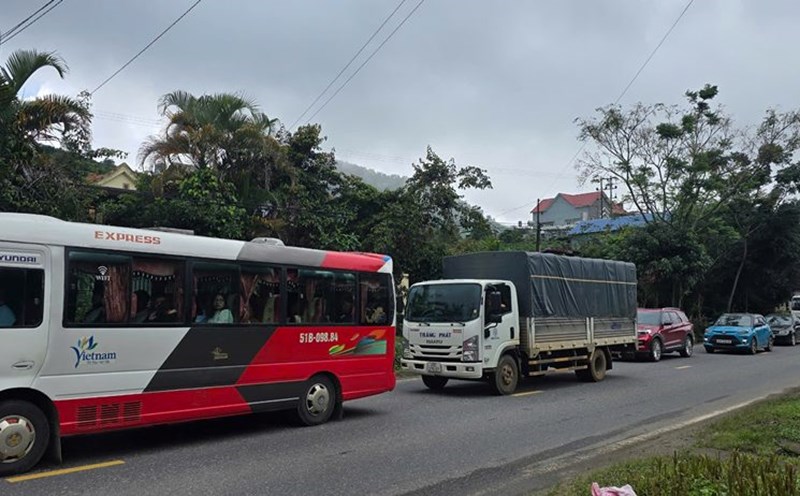Build more bridges, open more roads
To connect Dong Nai, in addition to National Highway 1 and Ho Chi Minh City - Long Thanh Expressway, Ho Chi Minh City will build a route from Thu Duc intersection to Ring Road 3 and connect to Dong Nai 2 Bridge; build Cat Lai Bridge connecting Nhon Trach District.
In particular, the southern coastal route starts from National Highway 50 (Tien Giang), crosses the Soai Rap River to Can Gio, and will connect Can Gio international transit port, Phuoc An port (Dong Nai) and Ben Luc - Long Thanh expressway. This route is 57.4km long, of which 38.2km belongs to Ho Chi Minh City, and is expected to be invested after 2030 with a scale of 4-8 lanes. To protect the Can Gio Biosphere Reserve, the section through this area will combine solutions on the ground, underground and viaduct. This is considered a coastal economic corridor connecting Ba Ria - Vung Tau, Dong Nai, Ho Chi Minh City and Tien Giang.
Ho Chi Minh City strengthens its connection with Binh Duong through National Highway 13, Ring Road 3, Ring Road 4, the Ho Chi Minh City - Chon Thanh Expressway connecting road and the Saigon River road. In particular, National Highway 13, from Binh Trieu Bridge to Binh Duong border, will build a 4-lane elevated road with a total investment of nearly 20,000 billion VND. In addition, the road connecting from Go Dua intersection to Ho Chi Minh City - Chon Thanh Expressway, nearly 2km long and 60m wide, will accommodate 6-8 lanes.
Three new routes will be built to connect Ho Chi Minh City and Long An, including National Highway 50B, 8.7km long (6 lanes), Vo Van Kiet extension road, more than 12km long (8-18 lanes), and the new Northwest road (from Ring Road 2 through Vinh Loc Industrial Park to Provincial Road 823D), 9.9km long (6-8 lanes).
Connecting with Tay Ninh, the Ho Chi Minh City - Moc Bai expressway, nearly 51km long with an investment capital of 20,000 billion VND, is expected to start construction in 2025 and be completed in 2027. Along with that, National Highway 22 from An Suong intersection to Ring Road 3, 8.7km long, will be expanded to 10 lanes.
Ho Chi Minh City also strengthens connections with Tien Giang via southern coastal routes, National Highway 50, National Highway 50B and Ho Chi Minh City - Trung Luong Expressway, etc.
Raising capital for infrastructure development
The capital investment demand for expressways, beltways, national highways, and provincial roads in Ho Chi Minh City from now until 2030 alone is nearly 10 billion USD (about 250,000 billion VND).
According to Chairman of the Ho Chi Minh City People's Committee Phan Van Mai, mobilizing capital for investment in transport infrastructure is a key factor to ensure the feasibility of the planning. In the context of limited budget, Ho Chi Minh City focuses on building a mechanism to mobilize diverse resources, from the budget, ODA, socialization to development investment funds, to attract domestic and international capital. The city prioritizes the effective exploitation of land resources, creating clean land funds for auction and bidding, using revenue from land use fees and public assets for key transport projects.
Ho Chi Minh City is also researching the issuance of local government bonds and borrowing capital from domestic and foreign financial institutions.
In addition, the city will exploit land funds around metro stations, beltways, and expressways, and apply the TOD model (urban development associated with public transport). Revenue from these activities will be prioritized for investment in urban railway projects and regional infrastructure.
According to Mr. Truong Minh Huy Vu - Director of the Ho Chi Minh City Institute for Development Studies, the biggest bottleneck facing the Southeast region is the lack of inter-provincial investment policies. There is no mechanism to use joint budgets between provinces, mobilize public-private partnerships or ODA capital for regional projects.
Mr. Vu stated that to meet the large infrastructure development needs, the region needs a strong financial tool. These sources of capital cannot rely solely on public investment but require the participation of private and foreign capital. Therefore, the regional infrastructure development fund is an important factor, with two proposed solutions: Building a specific mechanism for the region or integrating it into the resolution on the International Financial Center in Ho Chi Minh City.












